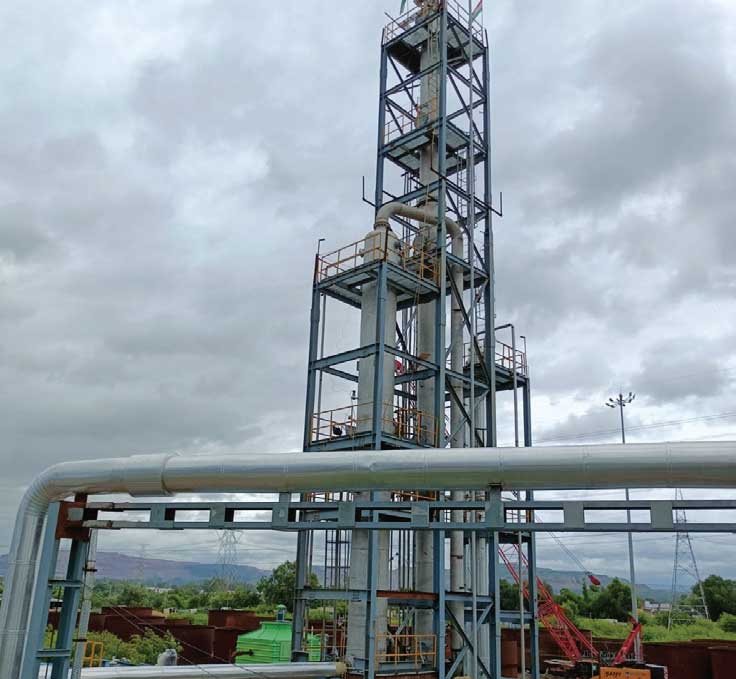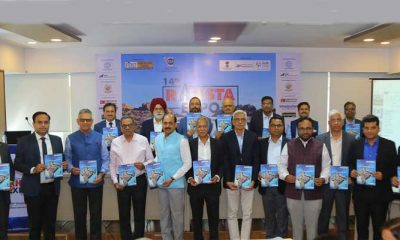Product development
Supreme Court pushes for Sustainability in Mining
Published
6 years agoon
By
admin
In this article, the authors have discussed the environmental interventions made by the Supreme Court in the mining sector. Further, the authors have analysed the consequential impact on various others industry sectors because of such interventions.
All the major countries of the world are striving for sustainable development. Sustainable development refers to the development that meets the needs of the present, without compromising the ability of future generations to meet their own needs. Both national and international organisations have highlighted the importance of sustainable development.
Mining is one of the major sectors, which plays a crucial role in the process of country’s economic development and acts as a catalyst for the growth of other core industries like power, steel, cement, etc., which, in turn, are critical for the overall development of the economy. India is one of the largest exporters of iron ore, chromite, bauxite, mica and manganese, and it is ranked fifth among the mineral-producing countries in terms of volume of production.
Mining includes activities like pitting, digging and quarrying among others undertaken to gainfully extract a mineral from the Earth’s crust. Mining is a fault-line of development which runs between environment and economy. It largely impacts the environment and sustainable development goals of the government. The judiciary has time and again made interventions in the mining sector in order to meet the threshold of sustainable development goals.
The Supreme Court intervention in mining operations dates back to the year 1997 when in Samatha v. State of A.P., (1997) 8 SCC 191, the Court recommended that at least 20 per cent of the profit be set aside as a permanent fund for development needs.
Goa Foundation v. M/s Sesa Sterlite Ltd & Ors. (February 7, 2018)
In Goa Foundation v. Union of India, (2014) 6 SCC 590, the Apex Court issued various directions considering the finding that illegal mining was committed in the State of Goa. One of such directions was, to the State of Goa, to frame a policy to decide in what matters mining leases are to be granted and such grant shall be subject to the provisions of Mines and Minerals (Development and Regulation) Act, 1957 (MMDR Act) and other related laws. Court in this case was aware and conscious of illegal and indiscriminate mining for which it did not interfere with State Government’s order suspending said mining leases. The court never intended renewal of said mining leases but instead intended that State should grant fresh mining leases.
Subsequently, on February 7, 2018, the apex court in ‘Goa Foundation v. M/S Sesa Sterlite Ltd. & Ors, (2018) 4 SCC 218’ cancelled 88 iron ore mining leases in the State. The court held that the State was obligated to grant fresh leases, rather than allowing second renewals, pursuant to its order in the case of Goa Foundation v. Union of India. The court also came down on the State for showing undue haste in renewing the mining leases, observing that the State was willing to sacrifice rule of law for the benefit of lease holders.
Common Cause v. Union of India (August 2, 2017)
The apex Court in ‘Common Cause v. Union of India, (2017) 9 SCC 499’ took notice of rampant and illegal mining going in the State of Orissa which was causing untold misery to tribal people in that area. There was over extraction of 2,155 lakh MT of iron ore and manganese ore. Rs 17,506 crore worth mineral ore produced without obtaining environment clearance. In such circumstances, court suspended various illegal mining activities going in Orissa. The grounds of dismissal were as follows:
The ambit of the phrase ‘illegal mining’ was also discussed in this case. The court held that illegal mining does not only mean mining outside lease area. Illegality may take place inside the lease area. Purpose of MMDR Act is to ensure scientific mining, balanced utilisation of natural resources and protection and preservation of environment by adhering to statutory requirements. Non adherence would invite penalty and termination of lease. Adherence to statutory provisions implies adherence to provisions of Environment (Protection) Act, 1986, laws pertaining to air and water pollution, Forest Conservation Act, 1980 and mining statutes.
Manohar Lal Sharma v. Principal Secy (August 25, 2014)
The Apex Court in ‘Manohar Lal Sharma v. Principal Secy., (2014) 9 SCC 516’ quashed the allocation of 214 coal blocks, which were allotted to private miners between 1993 and 2011. It was held that the allotment of coal blocks made by the Screening Committee of the Government of India were arbitrary and illegal as the allotment did not meet the requirements of the procedure laid down in the statute. The court largely relied on the CAG report of 2012, which assessed the loss to the exchequer to the tunes of 1.86 lakh crore due to this illegal coal block allocation. Apart from these, there have been other judgments wherein the Apex Court has interfered in the mining sector. The table mentions all the important judgments showing the intervention of the Supreme Court in the mining sector.
Intergenerational equity (rationale for interventions by the SC)
Majorly, the Apex Court has interfered on the grounds of sustainable development and the principle of intergenerational equity. The principle of intergenerational equity states that we, the human species, hold the natural environment of our planet in common with all members of our species: past generations, the present generation, and future generations. As members of the present generation, we hold the Earth in trust for future generations. At the same time, we are beneficiaries entitled to use and benefit from it.
Three principles form the basis of Intergenerational Equity. The first principle relied on is called the principle of "conservation of options". This requires each generation to conserve the diversity of the natural and cultural resource base in such a manner that the options available to future generations are not restricted. The second principle relied on is the principle of "conservation of quality". This was with reference to the submission that future generations should not be subjected to a quality of the planet worse than what it is today. In other words, future generations are also entitled to quality enjoyment of the diversity in the natural and cultural resource base. The third principle relied upon was the principle of "conservation of access" which is to say that future generations have an equitable right to access the diversity of the natural and cultural resource base as is available to the present generation.
Consequential impact of such interventions on other sectors
Out of the total industrial sector, mining contributes around 10 – 11 per cent of the country’s GDP. Interventions in the form of ban on mining, cancellation of leases will largely impact other sectors also. The first and foremost impact of such ban occurs on the employment of people. Since a chunk of the State population, where mining is conducted, is involved in the mining operations including truck drivers. Mining ban or cancellation of leases will leave a large chunk of population jobless which will impact the GDP of the State.
Second, manufacturing sector will be affected since the manufacture of a lot of products depends upon the supply of minerals and most of the manufacturers depend upon local supply generated through mining. Complete ban will forced the manufacturers to import minerals from other States which consequently will impact the final price of the product or it will lead to force closure of such manufacturing units.
Third, mining has been a source of revenue generation for many states and such bans largely impact the State exchequer. It is to be noted that the impact may lead to reduction in the GDP of the State. Apart from these various other dependent sectors will be affected and therefore the Supreme Court should consider the consequences before making such interventions.
Conclusion
Banning and cancellation of mining leases will increase our dependence on import as we have to import massive volumes of these minerals, putting more pressure on State exchequer, rendering industries uncompetitive and generating a massive loss of employment. The court should put together a group of relevant experts and industry personnel to find a way out of this imminent disaster.
Two suggestions can be made here for a possible way forward:
Implementation of these suggestions may allow to meet its goal of sustainable development along with gaining economic development. Complete ban of mining activities is not the solution, we have to be better regulators and enforcement of policies by the State agencies is the need of the hour.
| Judgement | Date | Findings | Minerals |
|---|---|---|---|
| Samatha v. State of Andhra Pradesh | 11.07.1997 | Government lands, tribal lands, and forestlands in the scheduled Areas cannot be leased out to non-tribals or to private companies for mining. | All |
| M.C. Mehta v. Union of India | 18.03.2004 | No mining should be allowed in the Aravalli mountain range in Haryana and Rajasthan. | All |
| Orissa Mining Corporation Ltd v. Ministry of Environment & Forests | 18.04.2013 | The Company was allowed to begin its $1.7 billion bauxite mining project only if it had the consent of the gram sabhas (village councils) in Niyamgiri hills. | Bauxite |
| Goa Foundation v. Union of India | 21.04.2014 | Illegal, uncontrolled and unmonitored mining in Goa. Cancelling of expired mining leases. | Iron ore |
| Manohar Lal v. Principal Secy. | 25.08.2014 | Quashing of allocation of coal blocks by the Central government between 1993 and 2011. | Coal |
| Common Cause v. Union of India | 02.08.2017 | Illegal and rampant mining found in State of Orissa. Suspension of illegal mining going on. | Iron ore and manganese ore |
Banning and cancellation of mining leases will increase our dependence on import.
ABOUT THE AUTHORS:
KG Singhania and Alok Vajpeyi of Singhania & Co. Mumbai
Disclaimer:
Singhania & Co., Mumbai – The information in this article is not intended to constitute legal or other professional advice or services. The information is not intended to be relied upon as the sole basis for any decision which may affect you or your business. Before making any decision or taking any action that might affect your business, you should consult a qualified professional adviser. Singhania & Co. shall not be responsible for any loss whatsoever sustained by any person who relies on the information contained herein.
You may like

Advertising or branding is never about driving sales. It’s about creating brand awareness and recall. It’s about conveying the core values of your brand to your consumers. In this context, why is branding important for cement companies? As far as the customers are concerned cement is simply cement. It is precisely for this reason that branding, marketing and advertising of cement becomes crucial. Since the customer is unable to differentiate between the shades of grey, the onus of creating this awareness is carried by the brands. That explains the heavy marketing budgets, celebrity-centric commercials, emotion-invoking taglines and campaigns enunciating the many benefits of their offerings.
Marketing strategies of cement companies have undergone gradual transformation owing to the change in consumer behaviour. While TV commercials are high on humour and emotions to establish a fast connect with the customer, social media campaigns are focussed more on capturing the consumer’s attention in an over-crowded virtual world. Branding for cement companies has become a holistic growth strategy with quantifiable results. This has made brands opt for a mix package of traditional and new-age tools, such as social media. However, the hero of every marketing communication is the message, which encapsulates the unique selling points of the product. That after all is crux of the matter here.
While cement companies are effectively using marketing tools to reach out to the consumers, they need to strengthen the four Cs of the branding process – Consumer, Cost, Communication and Convenience. Putting up the right message, at the right time and at the right place for the right kind of customer demographic is of utmost importance in the long run. It is precisely for this reason that regional players are likely to have an upper hand as they rely on local language and cultural references to drive home the point. But modern marketing and branding domain is exponentially growing and it would be an interesting exercise to tabulate and analyse its impact on branding for cement.
Concrete
Indian cement industry is well known for its energy and natural resource efficiency
Published
1 year agoon
November 18, 2022By
admin
Dr Hitesh Sukhwal, Deputy General Manager – Environment, Udaipur Cement Works Limited (UCWL) takes us through the multifaceted efforts that the company has undertaken to keep emissions in check with the use of alternative sources of energy and carbon capture technology.
Tell us about the policies of your organisation for the betterment of the environment.
Caring for people is one of the core values of our JK Lakshmi Cement Limited. We strongly believe that we all together can make a difference. In all our units, we have taken measures to reduce carbon footprint, emissions and minimise the use of natural resources. Climate change and sustainable development are major global concerns. As a responsible corporate, we are committed with and doing consistent effort small or big to preserve and enrich the environment in and around our area of operations.
As far as environmental policies are concerned, we are committed to comply with all applicable laws, standards and regulations of regulatory bodies pertaining to the environment. We are consistently making efforts to integrate the environmental concerns into the mainstream of the operations. We are giving thrust upon natural resource conservation like limestone, gypsum, water and energy. We are utilising different kinds of alternative fuels and raw materials. Awareness among the employees and local people on environmental concerns is an integral part of our company. We are adopting best environmental practices aligned with sustainable development goals.
Udaipur Cement Works Limited is a subsidiary of the JK Lakshmi Cement Limited. Since its inception, the company is committed towards boosting sustainability through adopting the latest art of technology designs, resource efficient equipment and various in-house innovations. We are giving thrust upon renewable and clean energy sources for our cement manufacturing. Solar Power and Waste Heat Recovery based power are our key ingredients for total power mix.
What impact does cement production have on the environment? Elaborate the major areas affected.
The major environmental concern areas during cement production are air emissions through point and nonpoint sources due to plant operation and emissions from mining operation, from material transport, carbon emissions through process, transit, noise pollution, vibration during mining, natural resource depletion, loss of biodiversity and change in landscape.
India is the second largest cement producer in the world. The Indian cement industry is well known for its energy and natural resource efficiency worldwide. The Indian cement industry is a frontrunner for implementing significant technology measures to ensure a greener future.
The cement industry is an energy intensive and significant contributor to climate change. Cement production contributes greenhouse gases directly and indirectly into the atmosphere through calcination and use of fossil fuels in an energy form. The industry believes in a circular economy by utilising alternative fuels for making cement. Cement companies are focusing on major areas of energy efficiency by adoption of technology measures, clinker substitution by alternative raw material for cement making, alternative fuels and green and clean energy resources. These all efforts are being done towards environment protection and sustainable future.
Nowadays, almost all cement units have a dry manufacturing process for cement production, only a few exceptions where wet manufacturing processes are in operation. In the dry manufacturing process, water is used only for the purpose of machinery cooling, which is recirculated in a closed loop, thus, no polluted water is generated during the dry manufacturing process.
We should also accept the fact that modern life is impossible without cement. However, through state-of-the-art technology and innovations, it is possible to mitigate all kinds of pollution without harm to the environment and human beings.
Tell us about the impact blended cement creates on the environment and emission rate.
Our country started cement production in 1914. However, it was introduced in the year 1904 at a small scale, earlier. Initially, the manufacturing of cement was only for Ordinary Portland Cement (OPC). In the 1980s, the production of blended cement was introduced by replacing fly ash and blast furnace slag. The production of blended cement increased in the growth period and crossed the 50 per cent in the year 2004.
The manufacturing of blended cement results in substantial savings in the thermal and electrical energy consumption as well as saving of natural resources. The overall consumption of raw materials, fossil fuel such as coal, efficient burning and state-of-the-art technology in cement plants have resulted in the gradual reduction of emission of carbon dioxide (CO2). Later, the production of blended cement was increased in manifolds.
If we think about the growth of blended cement in the past few decades, we can understand how much quantity of , (fly ash and slag) consumed and saved natural resources like limestone and fossil fuel, which were anyhow disposed of and harmed the environment. This is the reason it is called green cement. Reduction in the clinker to cement ratio has the second highest emission reduction potential i.e., 37 per cent. The low carbon roadmap for cement industries can be achieved from blended cement. Portland Pozzolana Cement (PPC), Portland Slag Cement (PSC) and Composite Cement are already approved by the National Agency BIS.
As far as kilogram CO2 per ton of cement emission concerns, Portland Slag Cement (PSC) has a larger potential, other than PPC, Composite Cement etc. for carbon emission reduction. BIS approved 60 per cent slag and 35 per cent clinker in composition of PSC. Thus, clinker per centage is quite less in PSC composition compared to other blended cement. The manufacturing of blended cement directly reduces thermal and process emissions, which contribute high in overall emissions from the cement industry, and this cannot be addressed through adoption of energy efficiency measures.
In the coming times, the cement industry must relook for other blended cement options to achieve a low carbon emissions road map. In near future, availability of fly ash and slag in terms of quality and quantity will be reduced due to various government schemes for low carbon initiatives viz. enhance renewable energy sources, waste to energy plants etc.
Further, it is required to increase awareness among consumers, like individual home builders or large infrastructure projects, to adopt greener alternatives viz. PPC and PSC for more sustainable
resource utilisation.
What are the decarbonising efforts taken by your organisation?
India is the world’s second largest cement producer. Rapid growth of big infrastructure, low-cost housing (Pradhan Mantri Awas Yojna), smart cities project and urbanisation will create cement demand in future. Being an energy intensive industry, we are also focusing upon alternative and renewable energy sources for long-term sustainable business growth for cement production.
Presently, our focus is to improve efficiency of zero carbon electricity generation technology such as waste heat recovery power through process optimisation and by adopting technological innovations in WHR power systems. We are also increasing our capacity for WHR based power and solar power in the near future. Right now, we are sourcing about 50 per cent of our power requirement from clean and renewable energy sources i.e., zero carbon electricity generation technology. Usage of alternative fuel during co-processing in the cement manufacturing process is a viable and sustainable option. In our unit, we are utilising alternative raw material and fuel for reducing carbon emissions. We are also looking forward to green logistics for our product transport in nearby areas.
By reducing clinker – cement ratio, increasing production of PPC and PSC cement, utilisation of alternative raw materials like synthetic gypsum/chemical gypsum, Jarosite generated from other process industries, we can reduce carbon emissions from cement manufacturing process. Further, we are looking forward to generating onsite fossil free electricity generation facilities by increasing the capacity of WHR based power and ground mounted solar energy plants.
We can say energy is the prime requirement of the cement industry and renewable energy is one of the major sources, which provides an opportunity to make a clean, safe and infinite source of power which is affordable for the cement industry.
What are the current programmes run by your organisation for re-building the environment and reducing pollution?
We are working in different ways for environmental aspects. As I said, we strongly believe that we all together can make a difference. We focus on every environmental aspect directly / indirectly related to our operation and surroundings.
If we talk about air pollution in operation, every section of the operational unit is well equipped with state-of-the-art technology-based air pollution control equipment (BagHouse and ESP) to mitigate the dust pollution beyond the compliance standard. We use high class standard PTFE glass fibre filter bags in our bag houses. UCWL has installed the DeNOx system (SNCR) for abatement of NOx pollution within norms. The company has installed a 6 MW capacity Waste Heat Recovery based power plant that utilises waste heat of kiln i.e., green and clean energy source. Also, installed a 14.6 MW capacity solar power system in the form of a renewable energy source.
All material transfer points are equipped with a dust extraction system. Material is stored under a covered shed to avoid secondary fugitive dust emission sources. Finished product is stored in silos. Water spraying system are mounted with material handling point. Road vacuum sweeping machine deployed for housekeeping of paved area.
In mining, have deployed wet drill machine for drilling bore holes. Controlled blasting is carried out with optimum charge using Air Decking Technique with wooden spacers and non-electric detonator (NONEL) for control of noise, fly rock, vibration, and dust emission. No secondary blasting is being done. The boulders are broken by hydraulic rock breaker. Moreover, instead of road transport, we installed Overland Belt Conveying system for crushed limestone transport from mine lease area to cement plant. Thus omit an insignificant amount of greenhouse gas emissions due to material transport, which is otherwise emitted from combustion of fossil fuel in the transport system. All point emission sources (stacks) are well equipped with online continuous emission monitoring system (OCEMS) for measuring parameters like PM, SO2 and NOx for 24×7. OCEMS data are interfaced with SPCB and CPCB servers.
The company has done considerable work upon water conservation and certified at 2.76 times water positive. We installed a digital water flow metre for each abstraction point and digital ground water level recorder for measuring ground water level 24×7. All digital metres and level recorders are monitored by an in-house designed IoT based dashboard. Through this live dashboard, we can assess the impact of rainwater harvesting (RWH) and ground water monitoring.
All points of domestic sewage are well connected with Sewage Treatment Plant (STP) and treated water is being utilised in industrial cooling purposes, green belt development and in dust suppression. Effluent Treatment Plant (ETP) installed for mine’s workshop. Treated water is reused in washing activity. The unit maintains Zero Liquid Discharge (ZLD).
Our unit has done extensive plantations of native and pollution tolerant species in industrial premises and mine lease areas. Moreover, we are not confined to our industrial boundary for plantation. We organised seedling distribution camps in our surrounding areas. We involve our stakeholders, too, for our plantation drive. UCWL has also extended its services under Corporate Social Responsibility for betterment of the environment in its surrounding. We conduct awareness programs for employees and stakeholders. We have banned Single Use Plastic (SUP) in our premises. In our industrial township, we have implemented a solid waste management system for our all households, guest house and bachelor hostel. A complete process of segregated waste (dry and wet) door to door collection systems is well established.
Tell us about the efforts taken by your organisation to better the environment in and around the manufacturing unit.
UCWL has invested capital in various environmental management and protection projects like installed DeNOx (SNCR) system, strengthening green belt development in and out of industrial premises, installed high class pollution control equipment, ground-mounted solar power plant etc.
The company has taken up various energy conservation projects like, installed VFD to reduce power consumption, improve efficiency of WHR power generation by installing additional economiser tubes and AI-based process optimisation systems. Further, we are going to increase WHR power generation capacity under our upcoming expansion project. UCWL promotes rainwater harvesting for augmentation of the ground water resource. Various scientifically based WHR structures are installed in plant premises and mine lease areas. About 80 per cent of present water requirement is being fulfilled by harvested rainwater sourced from Mine’s Pit. We are also looking forward towards green transport (CNG/LNG based), which will drastically reduce carbon footprint.
We are proud to say that JK Lakshmi Cement Limited has a strong leadership and vision for developing an eco-conscious and sustainable role model of our cement business. The company was a pioneer among cement industries of India, which had installed the DeNOx (SNCR) system in its cement plant.
Concrete
NTPC selects Carbon Clean and Green Power for carbon capture facility
Published
2 years agoon
October 12, 2022By
admin
Carbon Clean and Green Power International Pvt. Ltd has been chosen by NTPC Energy Technology Research Alliance (NETRA) to establish the carbon capture facility at NTPC Vindhyachal. This facility, which will use a modified tertiary amine to absorb CO2 from the power plant’s flue gas, is intended to capture 20 tonnes of CO2) per day. A catalytic hydrogenation method will eventually be used to mix the CO2 with hydrogen to create 10 tonnes of methanol each day. For NTPC, capturing CO2 from coal-fired power plant flue gas and turning it into methanol is a key area that has the potential to open up new business prospects and revenue streams.

RAHSTA to showcase cutting-edge road construction tech, says NCC Director

RAHSTA will drive road construction innovation: Sundaresan

New appointment at TMEIC

Social Impact Award for Ambuja Cements

UCWL unveils new plant in Dabok, Udaipur

Environment Ministry revises rules of solid waste management

M-sand boards new terrain

Process and quality optimization in cement plant.
Concrete: A Highly Sustainable Building Material

Adani Group eyes Jaiprakash Associates’ Shahabad cement plant
Trending News
-

 Economy & Market2 weeks ago
Economy & Market2 weeks agoRoad construction industry to launch RAHSTA Expo 2024
-

 Concrete1 week ago
Concrete1 week agoFiltration can help to control climate change
-

 Economy & Market2 weeks ago
Economy & Market2 weeks agoRoad construction leaders launch RAHSTA Expo 2024 in Delhi
-

 Economy & Market2 weeks ago
Economy & Market2 weeks agoRoad construction industry launches RAHSTA Expo 2024 in Delhi



